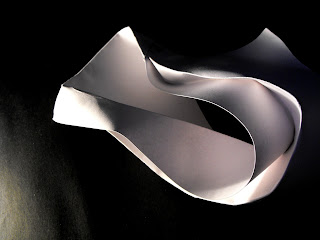I've decided that the method with the best results for me has been pleating the paper to create a twisted form. I think this really interprets the shape of a wave and is individually very nice to look at. I have thought about various ways of displaying these sculptures and i think they will look at their best when hung. I decided to research into chandeliers that have been made out of paper and how they have been arranged to look at their best when hung.
I think this is probably a pretty simple design but it looks really effective mainly due to the lighting that has been used. I think this is a really important factor i need to think about when displaying and photographing my final piece.
This piece looks as though it has been hung from a main ring structure that is hidden under the paper. This means the majority of the paper is left to hang naturally.
These pieces look really complex which makes them facinating to look at anyway but i really like the way they are hung low to the floor.
This has been hung to create quite a traditional chandelier shape but each paper cut out has been individually hung. This makes it very busy to look at but creates some amazing shapes.
The reason this one caught my eye is the way each model has been made at a different size and hung at a different level. I think this would work really well with the models i am planning to create.
The shape of this one really caught my eye and how it had actually been used as a lamp shade and lit from within. I think the lighting really expresses the shape of the model and creates interesting shadows.
I then decided to look at chandeliers that wern't made out of paper but used the same shapes that i am planning to use.
All three of these show glass chandeliers that have used a similar shape to that i will use for my final piece. All three of them are arranged and presented in very different ways. I really like the shape created in the middle one and how third one has been seperated into three sections.



































